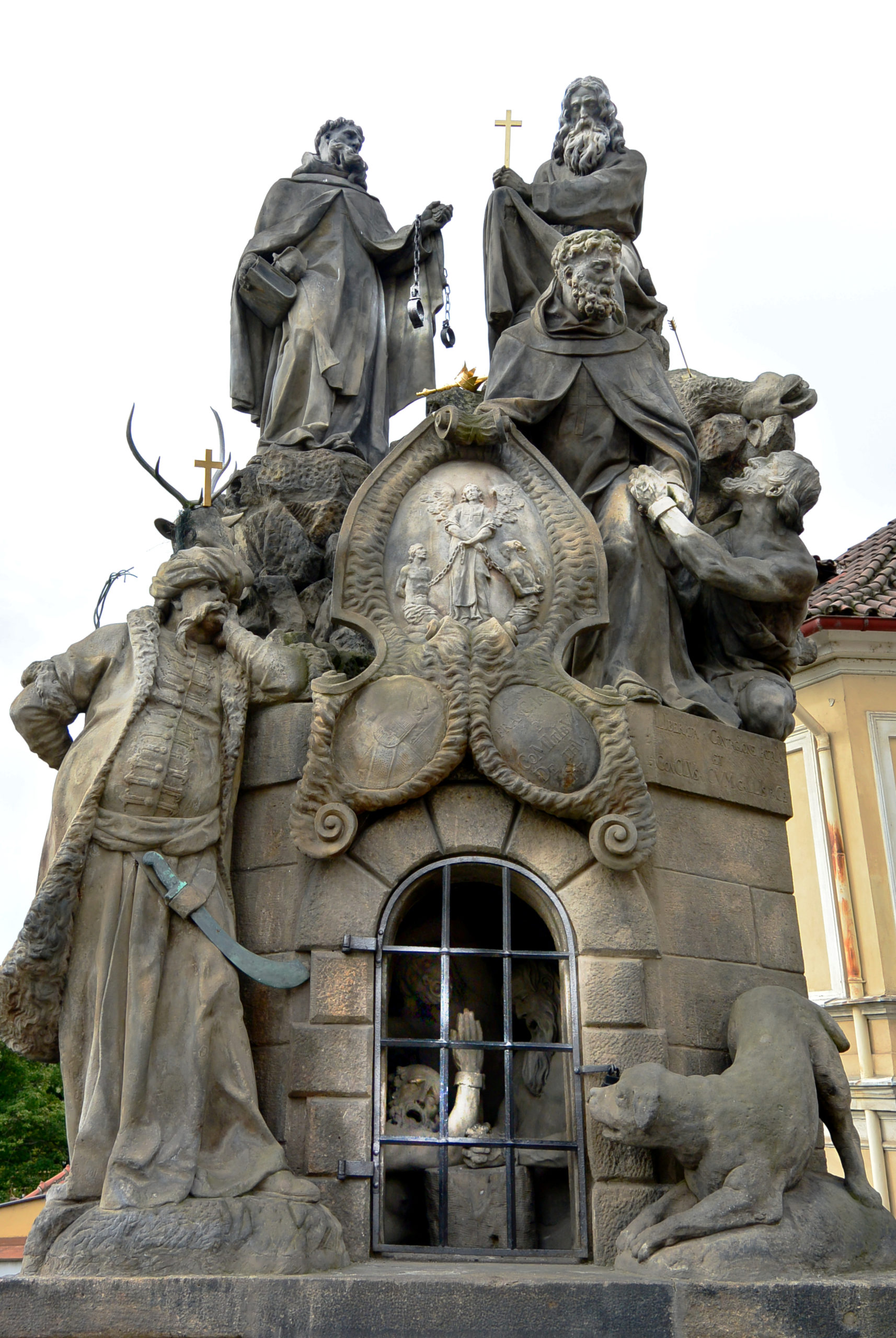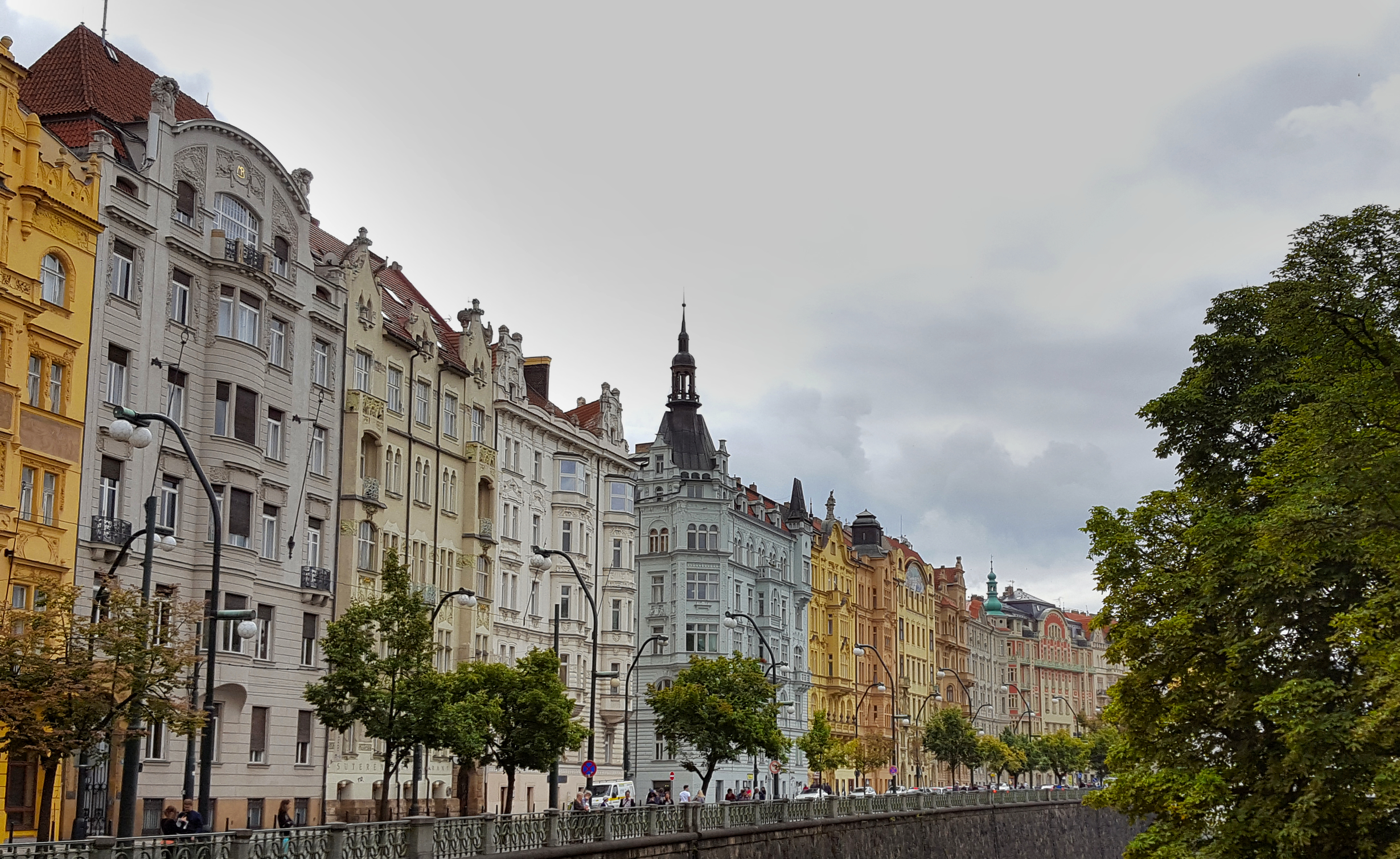Arriving in Prague, we were immediately struck by the feeling of hostility and oppression that the late medieval Gothic architecture conveys; the lines are hard, corners abrupt, and edges as sharp as knives. The intricate textures of spires and towers lace the sky and inspire visions of fantastic beasts and haunting spirits.
There is no buffer zone between the green spaces enveloping the outskirts of Malá Strana, the slow and steady flow of the river Vltava, and the oppressive but stunningly beautiful edifices transporting you to a bygone era, when the mystique of religiosity and alchemy indisputably reigned sovereign over the citizenry and nobility alike, dichotomous forces that permeate the city to this day.
The labyrinthine cobblestone streets make their way up hills, around narrow corners, and down alleyways, as if they were an enigma to be solved, a symbol of a winding path leading to redemption, to be sought and obtained through blind belief and perseverance.
The imposing and elevated location of the Prague Castle and St. Vitus Cathedral is a constant reminder of the obedience one owes to god and ruler and the impermanence of the human condition.
After an obnoxiously long flight, followed by a short train ride and the final leg on a bus, we dropped our bags at a small inconspicuous hotel and took off through the maze of streets, parking lots, and cafe seating areas. We had no particular direction, just a travel-weary interpretation of maps memorized while planning the trip. The city-flow captured us immediately, leading to unexpected sights that go often unnoticed under rigorous travel itineraries.
The Vltava River came into view as we emerged from a narrow road leading out of a dense mass of buildings acting as a curtain, blocking your senses. After crossing a busy street to a pedestrian path along the river, it felt as though a fog had been lifted, as the view over the river emerged, perfectly framing the great expanse of Malá Strana in a phantasmagorical setting atop the hill.
Down the road to the south, the Dancing House with its smooth, curved lines stood out juxtaposing with the surrounding architecture. As dusk set in and the pace of city-life began to surrender to the calm of the evening, the neutral tones of the house assumed the warm hues of a sun-setting sky. The harsh-edged spires dotting the cityscape became adorned in reds and yellows. Behind us, the river turned to liquid gold.
In the evening, the streets of Old Town (Staré Město, in Czech) were flocking with street performers and artists. Knowing that generally street artists gather where the tourists are, we opted to venture through less crowded alleyways. Our decision paid off, as we ran into a spectacle we had never witnessed before. An unusual performance was unfolding right before our eyes – a musician playing classical opera with crystal glassware. It may sound simple, but it definitely wasn’t. His console counted of roughly 3 dozen crystal glasses in various shapes, containing different degrees of water. The concept is simple, the water produces waves and the waves colliding against the crystal emit sounds, but the resulting melody was astonishingly beautiful and ethereal. Rain had begun to fall on our heads, but the spectacle was far too captivating to even notice.
The vortex of feelings and emotions accompanied us through the entirety of our stay in the city, as we ventured through its many historic and cultural attractions. The complexity of the regional history is reflected not only on the facades of the medieval buildings, but even more so on the detailed interiors, depicting grotesque scenes and the powers of good and evil. Some personal perspective and recommendations on attractions in the area are found below.
Attractions – from the Famous to the Particular
Prague Castle and the Malá Strana Quarter
Keep in mind that the Prague Castle is a large complex made up of a number of cultural and historic buildings (just the castle itself has over 700 rooms), so reserve at least an entire afternoon if you want to see the sight in its entirety. For info and details about hours, entry tickets, and tours, please visit https://www.hrad.cz/en/prague-castle-for-visitors. there is also an interactive map accessible through this site.
Partly set up as a museum with permanent collections, the castle often hosts concerts and art exhibits. Since the complex is a citadel located on the top of the hill overlooking the rest of the city, the Palace’s windows and balustrades offer artistic views over the surrounding gardens and buildings. The architectural gothic marvel of St. Vitus Cathedral is also located within the Castle’s walls.
Leaving the Castle, you will be promenading through the streets of Malá Strana, or the “Lesser Town.” Here, you will find many tourist shops selling souvenirs and street food, as well as the Franz Kafka Museum, the Lennon Wall, Museum of Alchemists and Magicians of Old Prague, and countless bars and restaurants. We recommend meandering through the maze of narrow streets and alleys and stopping at one of the taverns along the Čertovka canal for lunch.
The Lennon Wall
In the aftermath of John Lennon’s assassination in New York City, a graffiti artist painted an image of Lennon’s face as a way to express dissidence against this heinous crime. Lennon being a symbol of the fight for justice, equality, and love to many generations, the Lennon Wall has been attracting countless thousands of artists and youths seeking to express their feelings through the Beatles-inspired imagery and lyrics. The authorities finally gave up the fight to keep the wall untainted, after years of failed attempts. People from all walks of life stop by the wall to commemorate the Beatles’ legacy and admire the paintings. The stunning bright colors inevitably make you believe that, despite everything, we can make the world a better place, if we just try. Hope still exists in this inconspicuous corner of the city.
Staré Město
Regardless of which way you are coming from, every small ally and narrow street of Staré Město leads you to Old Town Square. Dating back to the 10th century, the square served as the city’s urban marketplace, as well as the main place for public gatherings and political discussions, up until the turn of the 20th century. Today, the square hosts concerts and holiday markets, primarily during Easter and Christmas seasons.
Baroque, Late-Gothic, and Early Renaissance edifices gently outline the square and guide the eye to the most magnificent monuments in this part of town. The Astronomical Clock and the conspicuous high-gothic Church of Our Lady Before Týn stand right there, in stark contrast against the smoother lines and pastel colors of the adjacent buildings.
It took almost 200 years to complete the Church of Our Lady Before Týn, and, although the exterior is an outstanding example of Gothic architecture, the interior boasts exquisite Baroque compositions. The entry is free, but donations are more than welcome.
The Astronomical Clock is attached to the Town Hall facade. It is the oldest astronomical clock still operational in the world! This instrument of marvel has been faithfully keeping track of time and movements of celestial bodies since the early 1400’s. The four humors (the small statuettes sitting on either side of the clock) represent vanity, greed, death, and paganism.
Mucha Museum
Not too far from Old Town Square, the Mucha Museum features a small, but very well curated, collection of the most renowned Art Nouveau artist Alphone Mucha. The gallery is inexpensive to visit (the entry ticket is about $12 USD for adults) and a nice break from the hustle and bustle of the city unfolding outside. If you have an appreciation for the Art Nouveau movement, I do recommend that you pay a visit.
Foodstuffs to Try
Chocolaterie
For all of you chocolate and cacao lovers, we recommend to stop in at Pražská čokoláda, on Nerudova 46 (there are other locations in the city, too – see the link for details: https://www.steinerkovarik.com/). After savoring a number of pralines and bars from other chocolatiers, we concluded that this shop stood victorious over all others in the city. If you like a kick in your chocolate, as I do, try the dark chocolate chili almonds.
Trdelnik
While walking the streets of Malá Strana, we noticed that the vast majority of passersby, tourists and locals alike, were munching on a hand-held cone made of sugary puff pastry. We began to pay attention as to where people were getting these cones from, and following the smell of caramelized sugar, we ended up in a tiny one-room shop.
The pastries are called Trdelnik, and are the iconic street food/pastry of Prague. The shop attendant took our order, took out a 2 foot long 2 inch wide strip of puff pastry, and coiled it tightly around burning hot rods. A couple of minutes passed and magic happened. She asked us what filler we wanted to put in the pastry, and we chose pistachio white chocolate paste. We held our cones of heavenly deliciousness and hit the road again. You can get Trdelnik filled with dark or milk chocolate, or whipped cream and ice cream, so, if you ever find yourself in a situation where you need to choose what to fill yours with, get creative and wrap yourself in the guilty pleasure of eating this sweet, warm, flaky pastry with the creamiest interior imaginable.
Eatery
Even if overly-tourist and kitch, if you have come all the way to Prague, you should want to have a hearty, and also very heavy, dinner at one of the many Medieval taverns. We are not the types of travelers who look for over-commercialized tourist experiences; in fact, we tend to avoid those like the plague. As it happened, we managed to find a local spot that celebrated its regional traditions without crossing over to an embellished tourist spectacle.
Located in the Old Town, and a few streets down the Jewish Quarter, Krčma is a dim, subterranean, candle-lit, dungeon of a tavern, quite literally. The half-window sills facing the street are entirely covered with thick candle wax dripping down the brick and mortar basement walls, evoking different, and perhaps simpler, times.
To the best of my knowledge, the restaurant doesn’t serve any vegan dishes, though vegetarian options are available (you can check out the menu here: https://www.krcma.cz/menu.) The portions were abundant and filling, to the point that after having devoured the two appetizers, the marinated cheeses and black beer baked sausage, we opted to order one entree only, and after some deliberation we ordered the traditional Cesky Goulash in a thick paprika gravy with a side of steamed dumplings.







